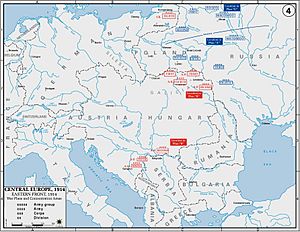Eastern Front (World War I) facts for kids
The Eastern Front of World War I was a huge area where Germany and Austria-Hungary fought against Russia. It was much bigger than the Western Front, stretching three to five times longer. This made it hard to move soldiers and supplies quickly, because there weren't many railways.
Russia faced many challenges and lost some battles. However, over time, their army got stronger. More and more allies also joined the war to support Russia. The fighting on the Eastern Front stopped in 1917. This happened because the Russian Civil War broke out in Russia between the Communists and another group called the Russian Social-Democratic Party. The Communists then signed a peace treaty with Germany. This allowed them to focus on winning the Civil War at home.
Images for kids
-
A timeline of events on the Eastern and Middle-Eastern theatres of World War I
-
Border changes in favor of Romania as agreed in the Treaty of Bucharest
-
An illustration from a French magazine about the Bosnian Crisis. Bulgaria declares its independence and its prince Ferdinand becomes Tsar. Austria-Hungary, led by Emperor Francis Joseph, takes over Bosnia and Herzegovina. The Ottoman Sultan Abdul Hamid II watches, unable to do anything.
-
Hindenburg at Tannenberg, painted by Hugo Vogel
-
Territory lost by Russia under the 1918 Treaty of Brest-Litovsk
See also
 In Spanish: Frente oriental (Primera Guerra Mundial) para niños
In Spanish: Frente oriental (Primera Guerra Mundial) para niños












